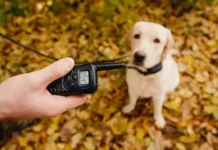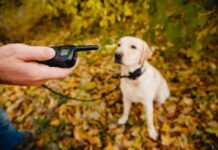In police dog training, a question often arises: do police dog trainers use shock collars? This article seeks to shed light on this widely debated topic.
We will explore the methods utilized by police dog trainers and delve into the effectiveness of shock collars when it comes to training these highly skilled animals.
Join us as we uncover the truth behind this controversial technique and its role in law enforcement.
Common Training Methods for Police Dogs
When training police dogs, different methods ensure that these highly skilled canines perform their duties effectively. The three main training methods commonly used are positive, negative, and a combination of both. Each method has its merits and considerations, and the choice of method often depends on the specific requirements of the police force and the individual dog being trained. Let’s look at these training methods and their respective techniques.
Positive Reinforcement Training
Positive reinforcement training focuses on rewarding desired behaviors to encourage repetition. In police dog training, treats and rewards are commonly used to reinforce positive behaviors. When a police dog performs a task correctly, such as obeying commands or completing an obedience exercise, they are rewarded with treats, praise, or playtime. This method motivates the dog and creates a positive association with the desired behavior.
Clicker training is another form of positive reinforcement used in police dog training. A small handheld device called a clicker is used to make a distinct clicking sound, which serves as a marker to indicate that the dog has performed the desired behavior. The dog then receives a reward immediately after hearing the click. This method helps to create a transparent communication system between the dog and the trainer, making it more efficient and effective.
Building a strong bond with the dog is also an essential part of positive reinforcement training. Police dog handlers often spend significant time with their dogs, engaging in activities that foster trust and companionship. This bond enhances the dog’s motivation and willingness to work and creates a strong partnership between the dog and the handler, resulting in better teamwork and overall performance.
Focusing on desired behaviors is another crucial aspect of positive reinforcement training for police dogs. By directing attention towards desired behaviors and reinforcing them, trainers can shape the dog’s behavior and train them to perform specific tasks effectively. Through consistent and targeted reinforcement, police dogs can demonstrate behaviors to their law enforcement role.
Negative Reinforcement Training
In contrast to positive reinforcement, negative reinforcement training focuses on applying aversive stimuli to discourage undesirable behaviors. Although this method is less commonly used in modern police dog training, it can still be found in some training programs. It is important to note that negative reinforcement training, when done correctly and ethically, does not involve physical harm or abuse towards the dog.
One technique used in negative reinforcement training for police dogs is using shock collars. These collars are designed to deliver a mild electric shock to the dog when a specific command is not obeyed. The intent behind using shock collars is to associate disobedience with a negative consequence, thus discouraging the behavior. However, trainers must use shock collars responsibly, ensuring the shock is administered appropriately and safely for the dog.
Collar corrections are another aspect of negative reinforcement training. With this technique, the handler applies pressure on the dog’s collar to redirect or correct a behavior. By varying the intensity and duration of the pressure, the handler can communicate to the dog that their current behavior is unwanted or incorrect.
Verbal reprimands are also used as negative reinforcement in police dog training. Commands such as “no” or “stop” are in a firm and assertive tone to communicate disapproval to the dog. Like any training method, consistency and timing are essential for the effectiveness of verbal reprimands.
Combination of Positive and Negative Reinforcement Training
Some police dog training programs utilize a combination of both positive and negative reinforcement techniques. This hybrid approach aims to strike a balance between rewards and corrections, tailoring the training to fit the specific needs of the individual dog and the tasks they will be performing.
The use of shock collars in combination with positive reinforcement is one example of this approach. While shock collars are generally considered a last resort and are used sparingly, they can be employed in specific situations where immediate and precise correction is required. The goal is to use shock collars to reinforce positive behaviors rather than rely solely on aversive stimuli.
Reward-based training remains the primary method in combination training. By focusing on positive reinforcement techniques, trainers can foster a cooperative and willing attitude in police dogs. This method leads to better overall welfare for the dogs and strengthens the bond between the dog and the handler, resulting in enhanced performance and reliability.
Arguments in Favor of Shock Collar Usage
While shock collars are controversial in police dog training, proponents argue that their usage serves specific purposes and can be effective when used responsibly and within ethical guidelines. Here are a few arguments put forth in favor of shock collar usage:
Quickly correcting dangerous behaviors
One of the main arguments for using shock collars in police dog training is their ability to correct dangerous behaviors quickly. In high-stress situations where the safety of officers, civilians, or the dog is at risk, immediate correction may be necessary to redirect the dog’s behavior. When used judiciously and as a last resort, shock collars can provide the rapid response needed to prevent potential harm.
Enhancing handler control in high-stress situations
Police dogs often encounter intense, high-stakes scenarios, such as suspect apprehension or search and rescue operations. In these situations, shock collars can assist in maintaining control over the dog and ensuring their adherence to commands. Proponents argue that shock collars can be invaluable for enhancing the handler’s ability to communicate effectively with the dog in such demanding circumstances.
Effective for specific types of training
Police dog training may require more control and precision, such as tactical deployments or specialized detection work. In these cases, shock collars can be used as a training tool to fine-tune the dog’s response and performance. Proponents suggest that shock collars, when used alongside positive reinforcement and with careful attention to the dog’s well-being, can enhance the effectiveness of these specialized training techniques.
Arguments Against Shock Collar Usage
Despite the arguments in favor of shock collar usage, there are prevalent concerns regarding the potential physical and psychological harm caused to dogs. Critics argue that shock collars are less humane and outdated as a training method and can hurt the dog-handler relationship. Here are a few arguments against shock collar usage in police dog training:
Potential for physical and psychological harm to dogs
Using shock collars risks inflicting physical and psychological harm on dogs. Critics argue that even when used at low levels, the electric shock can cause pain, fear, and anxiety, leading to unnecessary distress for the dog. Furthermore, the unintended consequences of using shock collars, such as suppressing the dog’s instincts or creating a fear-driven response, can have long-lasting adverse effects on the dog’s well-being.
The less humane and outdated training method
As our understanding of animal behavior and training techniques evolves, there is growing consensus that positive reinforcement methods are more humane and effective than aversive stimuli. Critics argue that shock collars belong to an outdated paradigm of training that relies on punishment and fear rather than building trust and cooperation. They advocate for more progressive approaches that prioritize the welfare and emotional well-being of the dogs.
Negative impact on the dog-handler relationship
A strong and trusting relationship between a police dog and their handler is essential for successful teamwork and performance. Critics argue that shock collars can erode this relationship by introducing fear and discomfort-into the training process. Instead of building a partnership based on communication and cooperation, using shock collars may create a dog-handler dynamic rooted in fear and distrust, ultimately compromising the team’s effectiveness.
Alternatives to Shock Collars
Recognizing the concerns surrounding shock collar usage, alternative training methods have emerged to address the needs of police dog training while employing more humane techniques. Here are some alternatives to shock collars used by police dog trainers:
Vibration collars
Vibration collars offer a gentler and less aversive alternative to shock collars. Instead of delivering an electric shock, these collars produce a vibrating sensation that serves as a mild deterrent or attention signal to the dog. Vibration collars can redirect a dog’s behavior without causing pain or distress.
Citronella spray collars
The citronella spray collars release a citronella scent when the dog exhibits unwanted behavior. As dogs have a strong sense of smell, the distraction created by the citronella spray can discourage the dog from repeating the behavior. This aversion-based method provides negative feedback without causing discomfort or harm.
Ultrasonic devices
Ultrasonic devices emit a high-pitched sound that is inaudible to humans but can be detected by dogs. These devices are used to interrupt unwanted behaviors or to gain the dog’s attention. With a sound deterrent, trainers can redirect the dog’s focus without resorting to aversive stimuli.
Positive reinforcement techniques
Positive reinforcement remains a crucial and widely accepted training method for police dogs. By rewarding desirable behaviors with treats, praise, and play, trainers can motivate and shape the dog’s behavior positively and reliably. This approach centers around building trust, strengthening the dog-handler relationship, and producing consistent and willing responses from the dog.
Police Dog Training Standards
Standards and protocols for police dog training vary across jurisdictions and are influenced by the policies set forth by the respective law enforcement organizations. While there are common threads and best practices within the field, each police force may have specific guidelines and requirements.
Training standards often incorporate considerations for ethical guidelines, animal welfare, and the overall effectiveness of the training program. These standards may cover obedience training, scent detection, tracking, apprehension techniques, and public interaction. Police dog trainers must understand and adhere to these standards to ensure the welfare and success of their canine partners.
Public Perception and Controversy
The use of shock collars in police dog training is a topic that evokes mixed opinions among the general public, professionals, and animal rights organizations. While some argue that shock collars can provide valuable control and safety measures, others advocate for their complete ban due to concerns about animal welfare and the long-term impact on the dog’s behavior and well-being.
Public perception and controversy surrounding shock collar usage have led to ongoing debates about the ethics and humaneness of training methods employed in police dog training. These discussions play a vital role in shaping the future of dog training practices and ensuring that the methods utilized prioritize the welfare and psychological well-being of the canine partners.
Ongoing Research and Innovation in Training Methods
The field of police dog training is continuously evolving, with ongoing research and innovation aimed at further refining training techniques and tools. By prioritizing evidence-based and positive reinforcement methods, trainers strive to improve the welfare and effectiveness of police dogs. Exploring new tools and techniques, such as scent detection technology and virtual reality training simulations, expands the possibilities for innovative and ethical training practices.
Support for evidence-based training approaches in police dog training is growing, emphasizing scientifically validated methods that enhance the well-being and performance of the dogs.
By staying informed about the latest research and advancements, police dog trainers can ensure that their training programs align with best practices and contribute to developing a more humane and practical field.




![Petrainer Dog Training Collar [100% Waterproof] Petrainer Dog Training Collar](https://mydogtrainingcollar.com/wp-content/uploads/2019/03/Petrainer-Dog-Training-Collar-218x150.jpg)




































